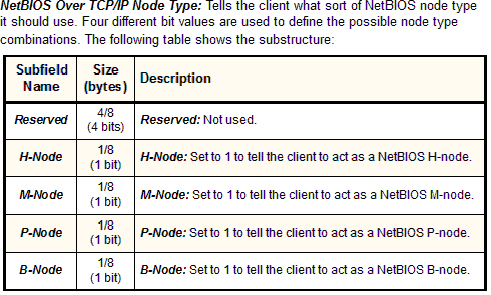Definition of NetBIOS over TCP/IP node types in Network Encyclopedia.
What is NetBIOS over TCP/IP node types?
NetBIOS over TCP/IP node types are different configurations or node types of NetBIOS over TCP/IP (NetBT) hosts. The node type determines how the NetBIOS naming functions are performed. For example, the naming functions can be performed by broadcast, by a NetBIOS Name Server (NBNS) such as a Windows Internet Name Service (WINS) server, or by both. The node type also determines the order in which the functions are performed.

The following list describes the NetBIOS naming functions (name resolution, name registration, and name release):
- NetBIOS name discovery: NetBT hosts that want to communicate with similar hosts must issue a NetBIOS name query request to resolve the NetBIOS name of the target server into its IP address.
- NetBIOS name registration: NetBT hosts must register their NetBIOS name when they are initialized on a network to ensure that there are no duplicate names on the network. NetBIOS name registration can be done either by broadcasts or by directed packets sent to a WINS server. Either or both methods can be used in either order, depending on the NetBT node type of the host.
- NetBIOS name release: NetBT hosts must release their NetBIOS names when they are shut down or when a particular NetBIOS-enabled service is stopped on the server. This enables the released name to be used by another host. NetBIOS name release can be done by broadcasts or by directed packets sent to a WINS server. Either or both methods can be used in either order, depending on the NetBT node type of the host.
The NetBIOS over TCP/IP node types are listed in the following table.
NetBIOS over TCP/IP Node Types
| Node Type | Method (in the Order Applied) | Comments |
| B-node (broadcast) | Broadcast only | Uses NetBIOS name queries for name registration and name resolution. Typically not forwarded by routers, so limited to local subnet. Can create excessive traffic in large networks. |
| P-node (peer-to-peer) | NBNS only | Uses NBNS, which is a single point of failure for NetBIOS naming functions. |
| M-node (mixed) | BroadcastNBNS | A combination of B-node and P-node. Uses broadcast by default. If unable to resolve, uses NBNS. |
| H-node (hybrid) | NBNSBroadcast | A combination of P-node and B-node. Uses NBNS by default. Default node type for Microsoft clients if an NBNS is configured on the network. |
| Microsoft enhanced B-node | NetBIOS name cacheBroadcastLmhosts file | An enhanced broadcast that utilizes the Lmhosts file. Default node type for Microsoft clients if no NBNS is configured on the network. |
Configuring NetBIOS node type
You can configure the NetBIOS node type directly on a Microsoft Windows NT client by using the registry, but the preferred way is to configure DHCP scope option number 46 on the DHCP server and configure the clients as DHCP clients.